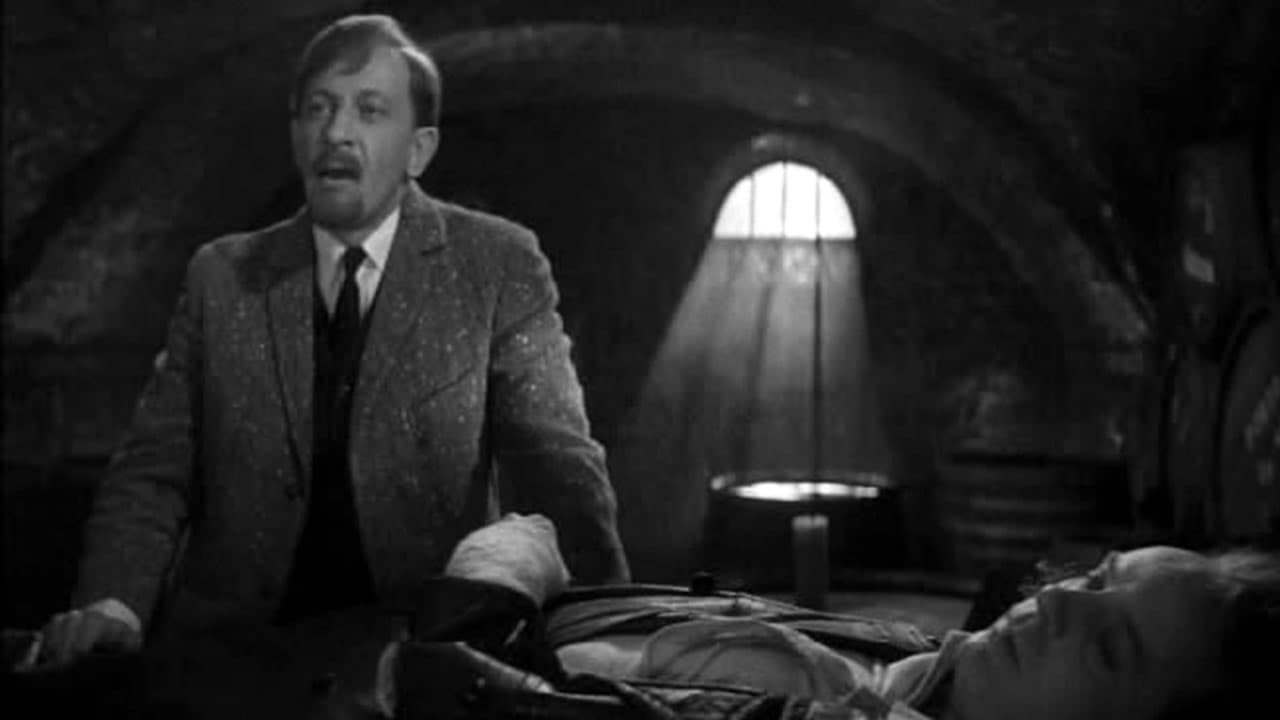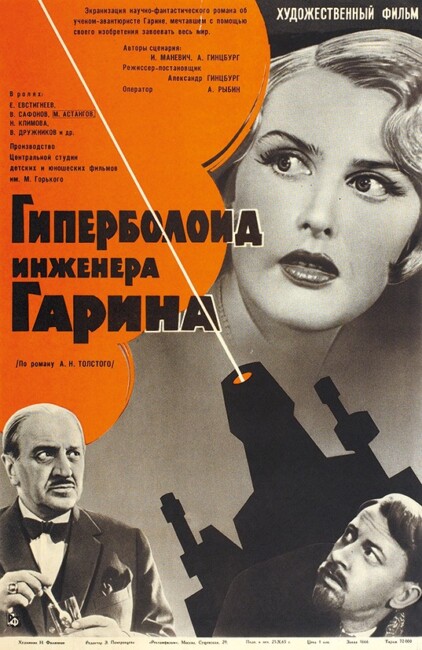(Giperboloid Inzhenera Garina)
USSR. 1965.
Crew
Director – Alexander Gintsburg, Screenplay – Alexander Gintsburg & Iosif Manevich, Based on the Novel The Garin Death Ray (1927) by Alexei Tolstoy, Photography (b&w) – Aleksandr Rybin, Music – Moisei Vainberg, Production Design – Yevgeni Galei & Meron Karyakin. Production Company – Gorky Central Studio of Children and Youth Films.
Cast
Yevgeny Yevstigneyev (Pyotr Petrovich Garin), Vsevolod Safonov (Vasily Shelga), Mikhail Astangov (Rolling), Natalya Klimova (Zoya Montrose), Vladimir Druzhnikov (Arthur Levy), Yurij Sarantsev (Tarashkin), Nikolai Bubnov (Nikolai Mantsev), Viktor Chekmaryov (Four-Fingered), Pavel Shpringfeld (Gaston ‘Duck Nose’), Alyosha Ushakov (Vanya Gusev), Valentin Bryleyev (Viktor Lenoir)
Plot
The year 1925. The Russian engineer Pyotr Petrovich Garin is sought because of his invention of the hyperboloid heat ray. A double of him is found murdered in the dacha he was using as a laboratory. Others seek to either kill or buy his idea as Garin flees from Paris to London, hiding in secret locations. All the while Garin searches for his old colleague Mantsev, who has gone into hiding, in order to confirm his findings. He makes a deal with the chemical industrialist Rolling. Using the hyperboloid, Garin creates a reign of terror, blowing up the plants of Rolling’s rivals. He then sets out on his grand ambition to use the hyperboloid to drill down to the Earth’s olivine layer and tap the vast supplies of gold there. However, this brings other nations seeking to destroy him as he throws markets into chaos.
Soviet era science-fiction is something that holds a great fascination as an x-ray of the zeitgeist of its times in exactly the same way that 1950s Hollywood B movies are fascinating historical artifacts for the way that they amplify fears of the Atomic Age and of the Communist threat. The Soviet films are fascinating in very different ways to their American counterparts – you can, for example, look through any of the Eastern Bloc science-fiction films of this era in vain in search of a work where they fear an invasion of the USSR by aliens that are a thinly disguised allegory for the United States. Moreover, there was only a single Soviet film, Letters from a Dead Man (1986) – which was made well into the era of perestroika – that deals with the issue of nuclear war and none at all that feature atomic monsters.
In contrast to American films, most of the Soviet science-fiction films of the 1950s and 60s seem political/ideologically driven works that feature noble scientists and engineers of the regime as they boldly carry the Communist cause to the stars. See efforts such as The Heavens Call (1959), Storm Planet (1962), Andromeda Nebula (1967), Moscow-Cassiopeia (1973), and works from non-Russian countries such as First Spaceship on Venus (1959) and Ikarie XB-1/Voyage to the End of the Universe (1963). Most of these were brought up by Roger Corman and AIP and re-edited into titles like Battle Beyond the Sun (1963), Voyage to the Prehistoric Planet (1965), Queen of Blood (1966) and Voyage to the Planet of Prehistoric Women (1968). These are not fearful films like their American counterparts, rather they seem lit up by the grand ideals of colonising the universe that caught the Soviet imagination during the Space Age. (For a more detailed listing see Soviet Cinema).
The Hyperboloid of Engineer Garin is based on The Hyperboloid of Engineer Garin/The Garin Death Ray (1927), a novel by Alexei Tolstoy, the writer whose original work also became the basis of the very first Soviet science-fiction film, the silent classic Aelita (1924). The film would appear to be a fairly accurate translation of the book from what I can gather, even retaining the 1920s setting of its original publication. The one thing that left me puzzled was the reference to the death ray as an hyperboloid. My immediate thought was to think of the literary term ‘hyperbole’, which means a form of exaggeration that is not meant to be taken literally, but apparently an hyperboloid is a curved three-dimensional surface.

The first half of The Hyperboloid of Engineer Garin takes place as a spy thriller. It is fascinating to see as a counterpoint to the numerous English-language Spy Films that were being made around this era such as the James Bond and Harry Palmer films or more serious works like The Spy Who Came in from the Cold (1965). These often featured the Soviets as villains but here we are seeing a spy film from the opposite side of the political fence. Like many of these others, The Hyperboloid of Engineer Garin takes place in a series of freewheeling international locations, which are often lavishly presented. I began to get into the film, impressed by the directorial style that Alexander Gintsburg was showing where many of the scenes are shot in an exaggeratedly heavy contrast of light and shadow that immediately recalls The Third Man (1949).
On the minus side, you get the feeling that the film is compacting down the complicated plotting that takes place in the book. What we end up with is a murkily incomprehensible plot that involves the murder of a double of Garin, international blackmail and sabotage, multiple murder plots and a number of factions running around all seeking to either kill Garin or get their hands on his discovery, at the same time as he tries to find a colleague who has gone into hiding in a remote part of the world.
It is when it unveils its hyperboloid about halfway through that The Hyperboloid of Engineer Garin starts to come to life as a science-fiction film. There is the fascinating scene where Yevgeny Yevstigneyev’s Garin is holed up in a villa as several people come after him and so switches the hyperboloid on and eliminates all his opponents by sweeping the heat ray across the door.
Thereafter the film abandons the spy thriller aspect and becomes a film about an amazing discovery. Here it starts to resemble one of the German classics of the early sound era – the likes of F.P.1 Does Not Answer (1932), The Tunnel (1933) and Gold (1934), which were films made about scientific discoveries that marvelled in the sheer power of engineering projects. There is a great fascination to the scenes of the machine drilling through the Earth to reach the olivine layer, the vast project built on the island and especially the scenes where Yevgeny Yevstigneyev turns the death ray around and uses it to eliminate a line of battleships that are approaching the island.
The Alexei Tolstoy book later underwent a colour remake as the Russian tv mini-series The Failure of Engineer Garin (1973).
Alexei Tolstoy (1883-1945) was a distant relative of Leo Tolstoy who enjoyed some popularity during the Soviet era. Tolstoy wrote some SF works and his stories have been adapted to the screen with Aelita (1924).
Full film available here


